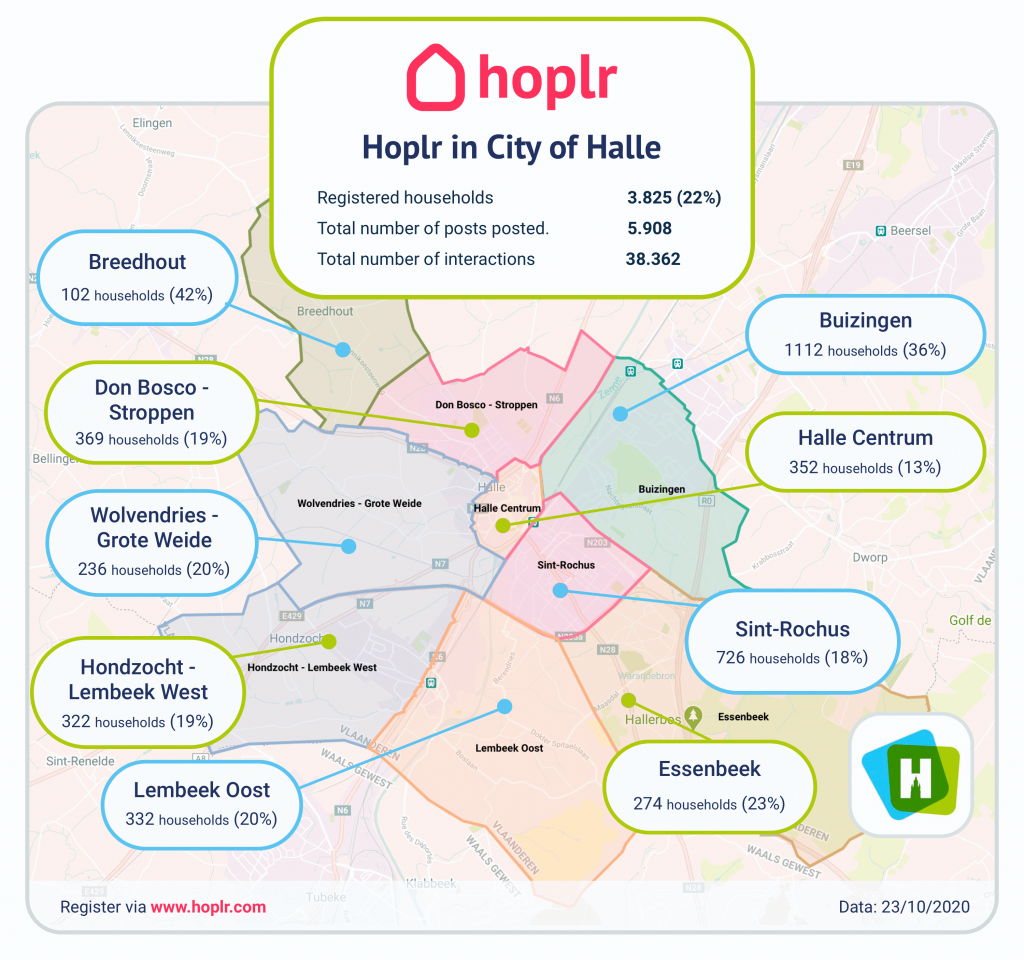Case Study: city of Halle consults citizens at street level with verified survey
Last year, the city of Halle received multiple reports about the traffic situation in a number of streets in Lembeek. There were five possible solutions. To determine the best possible solution, the city board consulted the streets’ residents. In this case study, we’ll demonstrate how the City of Halle the city government achieved an excellent participation rate of 27% with the Hoplr participation module.
In this article:
Concept: an extensive survey at street level
In choosing the best mobility solution, the city of Halle consulted the most important stakeholders, namely residents of the nine affected streets. The city council wanted to use Hoplr to:
- publish an extensive (62 questions) questionnaire* that is user-friendly to both surveyor and respondent;
- reach as many respondents as possible; and
- verify that respondents actually live in one of the streets.
(*) Side note: Hoplr since then recruited a PhD in Communication Sciences. As Citizen Participation Expert and Data Analyst, dr Jonas De Meulenaere helps draw up and process surveys. Municipalities with a Smart City License to our Service Dashboard can call on his expertise for free. However, since this survey took place last summer, an external party helped the city of Halle with the content of this particular survey.
Solution: verified survey using national registration number
In addition to online community building, Hoplr offers numerous functionalities to survey citizens. The verified or closed survey is one of them. Citizens must first verify their identity and can then go on to complete a questionnaire. Verification happens by the use of a unique code. This might be a randomly generated code delivered to the population by an invitation letter, for instance. In this case, we opted for the use of the national registration number.

This is how the city of Halle used Hoplr to survey the residents of the affected streets.
- Design: The City of Halle could easily input and launch the questionnaire via the participation section of the Service Dashboard. It offers different question forms such as matrices, rating scales and ranking questions.
- Publication: The City of Halle distributed a letter in the relevant streets, containing the public link to the questionnaire. With just a click of a button, the city shared the questionnaire with Hoplr neighbourhood Lembeek Oost as well. Finally, we provided a PDF, making a paper version available upon request.
- Verification: Respondents were asked to enter their national registration number for verification purposes. This gave respondents access to the survey. The survey itself was, of course, completely anonymous.
- Visibility: The questionnaire was highlighted within the Hoplr neighbourhood for its entire duration. Upon publication, all neighbours from Lembeek Oost received an e-mail or push notification (unless they had these turned off). The Service Dashboard allowed the city to post reminders in the neighbourhood.
- Support: As always, respondents could turn to the Hoplr team for technical issues (e.g. an issue caused by an outdated browser).
- Processing: Our participation module offers a continuous visual presentation of the results. Once the survey was closed, the local government could export the data for smooth processing.

We soon noticed that the URL in the letter was initially incorrect. After a few concerned phone calls and emails, we sent out a general call and a new letter, quickly resolving this error.
Dries Boelens, Expert communication, participation and conversation for Stad Halle
Results of the verified survey
200 out of 750 families participated. This equates to a participation rate of about 27%. This is a fantastic result for a very long questionnaire. Furthermore, 110 of the 200 respondents signed up to enter into dialogue with the board, during an offline moment. That’s a whopping 15% of households in the affected streets.

Hoplr in the city of Halle
Three citizens of Halle took initiative and launched Hoplr neighbourhood Buizingen in the spring of 2019. Two brothers and a friend delivered an invitation letter to every single one of the neighbourhood’s 3,500 households. Today, one in three households in Buizingen is registered to Hoplr.
The city of Halle immediately picked up on this signal from the neighbourhood and recognised Hoplr’s value for the entire city. By 2020, all neighbourhoods of Halle were connected to the online neighbourhood network. 21.5% of the households are now registered.
It’s nice to see people actively using Hoplr to ask each other questions or share ideas. We often receive constructive and enthusiastic responses to our own announcements.
Dries Boelens, Expert communication, participation and conversation for Stad Halle

Via Hoplr, the local government can easily engage in dialogue with a considerable part of the population. With the support of a team of experts and plenty of participation functionalities, Hoplr is an excellent medium for various citizen engagement projects.






